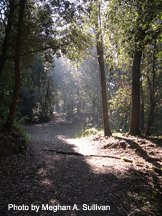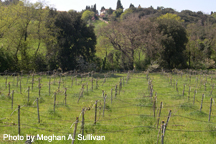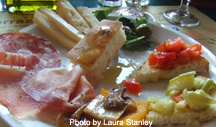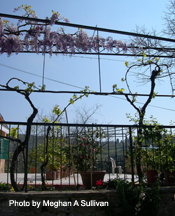A Taste of Tuscany
by
Meghan A. Sullivan
 Chianti, Tuscany is a region famous for its wine, but hidden within its natural landscape and old villas are a host of other fascinating secrets. I visited Tuscany with three friends during a semester abroad in Europe. Tall cypress trees, orange-red terracotta roofs, olive groves, and vineyards greeted us as our train wound through the countryside. To get a better taste of the Tuscan countryside, we embarked on a walking tour of Tuscany, organized by the Florence-based travel company Artviva.
Chianti, Tuscany is a region famous for its wine, but hidden within its natural landscape and old villas are a host of other fascinating secrets. I visited Tuscany with three friends during a semester abroad in Europe. Tall cypress trees, orange-red terracotta roofs, olive groves, and vineyards greeted us as our train wound through the countryside. To get a better taste of the Tuscan countryside, we embarked on a walking tour of Tuscany, organized by the Florence-based travel company Artviva.
The tour began in Florence, where we took a bus to the nearby hilltop town called Fiesole. Fiesole sits above Florence and, for a town so close to a bustling city, it has retained its quiet charm. As we walked along the outer edge of the town and looked into the mist-covered valley in which Florence was nestled, our tour guide Leslie presented the history of the area. Fiesole is older than Florence, and historians believe that the ancient Etruscans settled there. The Etruscans planted cypress trees in Tuscany because they believed the tall trees, which can live for up to 2000 years, lifted souls up to heaven. Because of this, cypress trees are often associated with death and immortality, but they are also indicative of the spirituality that pervades this region.
We soon arrived at the entrance of a cypress-filled park, Parco di Montececeri. Prior to the 1800’s, dating as far back as the Etruscans, the hill that the park covers was used as a quarry. Some of the ancient stone cuttings are still visible. At one point in the tour, we climbed a relatively steep slope to investigate an unfinished carving of a column. In the 1800’s, the wealthy Englishman John Temple Leader moved to Tuscany and decided to plant trees on the bare hill to create a protected park.
 Our walk through the forest not only afforded us with beautiful views and photo opportunities of Chianti and Florence, but it also equipped us with time in the great outdoors. As we passed bushes and rocks, the sun shone through the trees and almost guided us along the trail. Leslie took us past an old haunt of Leonardo Da Vinci’s. On what is now a rocky overhanging, Da Vinci tested many of his flying machines. He often took servants with him and strapped them to his machines, until one day a servant did not return. Word spread, and until his death, Da Vinci was forced to test his flying contraptions alone.
Our walk through the forest not only afforded us with beautiful views and photo opportunities of Chianti and Florence, but it also equipped us with time in the great outdoors. As we passed bushes and rocks, the sun shone through the trees and almost guided us along the trail. Leslie took us past an old haunt of Leonardo Da Vinci’s. On what is now a rocky overhanging, Da Vinci tested many of his flying machines. He often took servants with him and strapped them to his machines, until one day a servant did not return. Word spread, and until his death, Da Vinci was forced to test his flying contraptions alone.
 When we emerged from the park, the Tuscan sun and vineyards were there to greet us. A road filled with tiny terracotta fragments replaced the dirt path we had traversed in the park. We passed some villas growing grapevines and roses and eventually reached our destination: the Villa di Maiano. The villa was originally built in 1400; in the 1800’s, John Temple Leader purchased and renovated it. Today the villa is owned by the famous Corsini family and is used for tours, filmsettings, and weddings.
When we emerged from the park, the Tuscan sun and vineyards were there to greet us. A road filled with tiny terracotta fragments replaced the dirt path we had traversed in the park. We passed some villas growing grapevines and roses and eventually reached our destination: the Villa di Maiano. The villa was originally built in 1400; in the 1800’s, John Temple Leader purchased and renovated it. Today the villa is owned by the famous Corsini family and is used for tours, filmsettings, and weddings.
By this point in the tour, the mist in the valley had lifted, so we paused to take more pictures of Florence and the Tuscan countryside. We also toured the grounds and gardens of the villa. Inside the villa, we viewed original paintings, furniture, and decorations and listened to stories associated with the house.
 The last hallmark of the tour was a gourmet lunch on a terrace at a working farm attached to the villa. The menu consisted of a selection of cheese, bread, salami and ham, appetizers, pasta, olives, and wine. Below the terrace was an olive press, where people from miles around come to press olives into olive oil. The olive oil we sampled with our bread was made at the farm. We drank delicious Chianti from Valdarno Superiore. Sitting on a terrace with the sun on our backs, sipping Chianti wine and sampling Italian cuisine, we felt as though we were in heaven.
The last hallmark of the tour was a gourmet lunch on a terrace at a working farm attached to the villa. The menu consisted of a selection of cheese, bread, salami and ham, appetizers, pasta, olives, and wine. Below the terrace was an olive press, where people from miles around come to press olives into olive oil. The olive oil we sampled with our bread was made at the farm. We drank delicious Chianti from Valdarno Superiore. Sitting on a terrace with the sun on our backs, sipping Chianti wine and sampling Italian cuisine, we felt as though we were in heaven.

One of the secrets I discovered in Tuscany was the simplicity with which Italians approach life. On our way back to Florence we passed a private vineyard, and Leslie commented on Italians, “Wine and olive oil. Throw in some bread, and they’ll be happy.” For a splendid afternoon in the Tuscan countryside, we were able to experience that happiness, too. Da Vinci wrote, “As a well-spent day brings happy sleep, so life well used brings happy death.” If the Etruscans experienced the pleasures we glimpsed and tasted during our tour, then I am confident that the ancient cypress trees lifted happy souls up to heaven.
